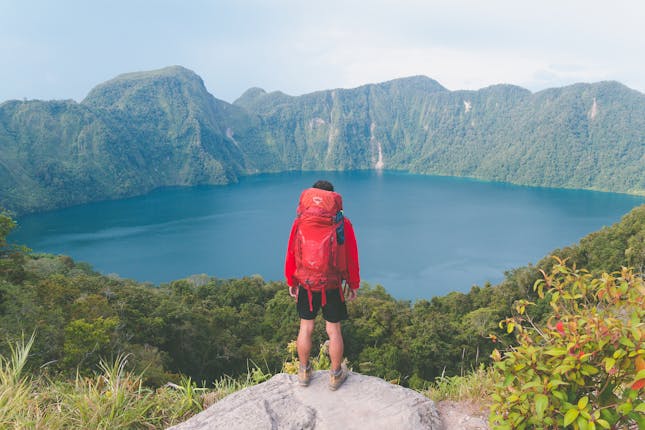
Embarking on your first hiking adventure can be both exciting and a bit daunting. With stunning trails waiting to be explored and the promise of breathtaking views, the allure of hiking is undeniable. However, the right gear can make the difference between an enjoyable hike and a challenging ordeal.
Imagine setting off on a trail with shoes that start to pinch or a backpack that digs into your shoulders. Or, picture finding yourself unprepared for an unexpected weather change. These are the scenarios that proper hiking gear can help you avoid.
What is essential hiking gear for beginners to embark on their hiking journey?
In this guide, I’ll walk you through the must-have items that every beginner hiker should consider. From selecting the right footwear to understanding the importance of layers, my goal is to ensure you’re equipped for a safe, comfortable, and enjoyable hiking experience. Having the right gear is essential for making the most of your time on the trail.
So, lace up your boots and get ready to discover the essentials that will pave the way for your hiking adventures.
Stepping Out in the Right Footwear
Let’s start by talking about something that’s going to carry you through every step of your hike, your footwear. Choosing the right hiking boots or shoes isn’t just a comfort thing; it’s a safety and performance thing, too. Your first priority should be finding a boot or shoe that fits like a glove – or, well, like a perfect pair of socks. A good fit means fewer blisters, better support, and a more enjoyable hike. You can find more information on hiking boots here.
Hiking Boots or Shoes?
My personal preference is boots, just for the fact that they give me better ankle support which I need after many ankle injuries playing netball as a youngster.
- Boots: There are mainly two types of hiking boots: day hiking boots which are flexible, lighter, and designed for shorter trips; and backpacking boots that are sturdier and suitable for multi-day treks with heavy packs. Waterproofing is another box to tick – it’s a game-changer that can keep your feet dry in damp conditions, but keep in mind that it also affects breathability.
- Shoes: Now, if your trail of choice is less rugged or you’re planning for a quick jaunt, hiking shoes might be your best bet. These are the lighter, more flexible cousins of boots. They usually offer less ankle support, which is fine when you’re packing light and sticking to well-maintained paths.
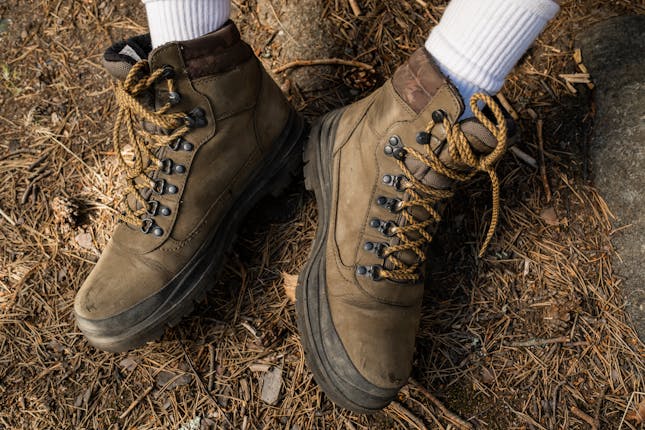

Socks
I can’t stress enough the importance of good quality socks. A thick, quality sock acts as cushioning and prevents rubbing and blisters. Wool, my preference, is a natural superstar with its ability to wick moisture and provide warmth even when wet. Synthetic blends are also a solid choice, quick-drying and helping you skirt around blisters. Look for socks with cushioning in the heel and ball of the foot – those are the spots that’ll thank you later. A great tip is to wear your hiking socks when trying on boots or shoes.
Dress for Success: Smart Hiking Attire
Now let’s talk about what you’re going to wear on the rest of your body. Getting your attire right is just as crucial as nailing down the perfect pair of hiking boots. Let’s explore how smart clothing choices can make a world of difference on the trails.
Upper Body
- Base layer: Layering is your best friend. Begin with a solid base layer made from moisture-wicking materials. This isn’t just about keeping you dry; it’s also about maintaining a consistent body temperature as you hike. You’re going to find fine merino wool or synthetic fabrics do the job nicely, pulling sweat away from your skin and letting it evaporate.
- Mid layer: Your mid layer is your insulating champion, keeping you warm when the temperature drops. Materials like fleece, my personal preference, or lightweight down are popular for their warmth-to-weight ratio, meaning they pack a punch without the weight. And when choosing this layer, remember that flexibility is key. You may need to shed or add this layer depending on the weather and your activity level.
- Outer layer: This is often referred to as a shell, is your shield against the elements. Look for waterproof and windproof jackets that breathe, so you don’t end up feeling like a walking greenhouse. Adjustable hoods, cuffs, and vents are features that can boost comfort significantly.
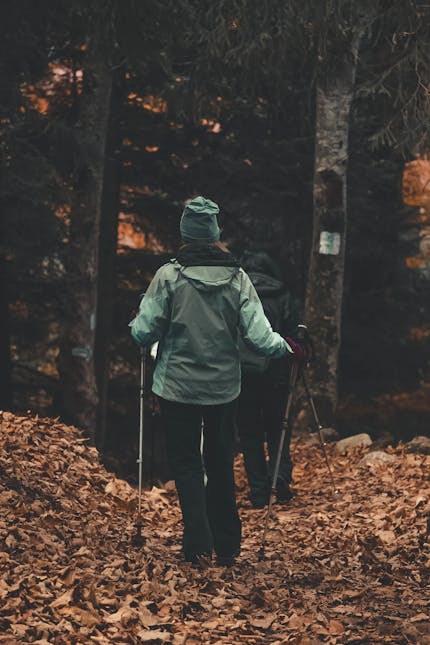
Pants
Next, let’s dive into the world of hiking pants and shorts. Some folks prefer convertible pants as they offer the flexibility of two garments in one, letting you zip off the legs to turn them into shorts when the day heats up. My preference is to wear pants all year as they protect my legs from scratches and too much sun.
Quick-drying materials should be high on your list when selecting pants or shorts. Fabrics that wick moisture and dry rapidly will keep you comfortable after water crossings or unexpected rain. In my opinion, choose pants with some stretch to facilitate a full range of movement as you scramble over rocks or navigate uneven terrain.

Accessories
A wide-brimmed hat and UV-blocking sunglasses are prime for protection against the sun. In cooler climates, you don’t want to be without a warm hat and gloves. And if you’re tackling tough terrain, a pair of gaiters can be a lifesaver, keeping debris and water out of your boots. In Australia they offer protection against snake bites.
With your clothing sorted, you’re going to be ready to consider how to carry all your on-trail essentials in the perfect backpack.
Finding Your Way: Effective Load Management
Now that you’ve got your clothing sorted, it’s time to talk about what you’re going to carry all your essentials in. A backpack can make or break a hiking trip; it’s not just about the look, it’s about how you pack and what you pack in.
Choosing the right backpack depends greatly on the duration of your hike. A daypack, generally smaller and lighter, is designed for those shorter trips when you need fewer items. Multi-day packs, on the other hand, offer more space for extra clothing, food, and a sleeping bag – crucial for those longer treks. It’s all about finding the right balance between size and necessity.
Fit is king when it comes to backpacks. A poorly fitting pack can lead to discomfort and even injury. You’re going to want to look for a backpack with adjustable straps that allow you to tailor the fit precisely to your torso length. A padded hip belt and shoulder straps can distribute weight more evenly, taking pressure off your back.
Features such as handy compartments help you stay organized, and believe me, nothing beats the convenience of knowing exactly where everything is on a long hike. Also, hydration compatibility is a big deal – most modern packs come with built-in sleeves for water reservoirs or pockets for water bottles. Easy access to water is essential, you don’t wan tto have to remove your backpack every time you want to drink and keeping hydrated is essential. My preference is a water bladder with a hose so I can sip away.
Weight distribution is another key factor; opt for a pack that allows you to pack heavier items close to your back and higher up for increased stability. More information on how to fit a backpack is here,

Trailblazing Tools: Navigating with Confidence
Heading into the wilderness without a map and compass is like trying to bake a cake without a recipe – it’s possible, but you’re going to run into a lot of uncertainty. For this reason, I’m a firm believer in always packing these two classic navigation aids. Not only do they serve as reliable tools when technology fails, but mastering their use is a fulfilling skill.
Map and Compass
A map offers more than just directions; it tells the story of the land you’re walking on. Contour lines reveal the terrain, symbols denote points of interest, and color coding provides critical info at a glance. Pairing that with a compass, you’re equipped to navigate through less-trodden paths safely. And remember, a compass doesn’t need batteries, so it’s always ready when you need it.
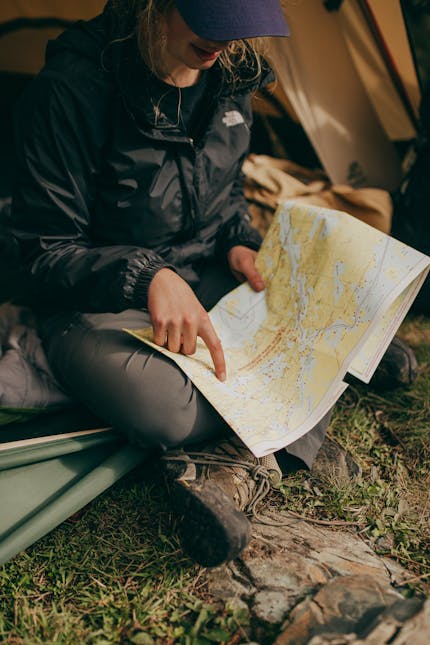
Technology
GPS devices and apps have undoubtedly made navigation much more accessible and convenient. With a handheld GPS unit, you’re getting purpose-built navigation that’s robust and often includes additional features like altitude readings. Smartphone apps are handier still and can provide you with a wealth of information at your fingertips. However, they’re also at the mercy of battery life, I carry a light weight power bank, and signal coverage. I recommend carrying a map and compass combo as a back up.
A good rule of thumb: pack your electronic devices but never let your traditional navigation skills get rusty. Practice them regularly, and you’ll navigate trails like a seasoned explorer. Trust me, the peace of mind that comes from this dual-approach is worth its weight in trail mix.
Safety First: Essential Medical and Emergency Gear
I’m going to help you understand the must-haves for your first aid kit and emergency supplies. This isn’t just about treating a scrape or two; it’s also about being prepared for the unexpected.
Your first aid kit should be more than a few adhesive bandages. It should include: disposible gloves, antiseptic wipes or antispetic, saline, various sizes of bandages including a snake bandage if walking in an area with snakes, sterile gauze pads, adhesive tape, tweezers, pain relief medication, and blister treatments. Contemplate the length of your hike and your specific needs when packing your kit.
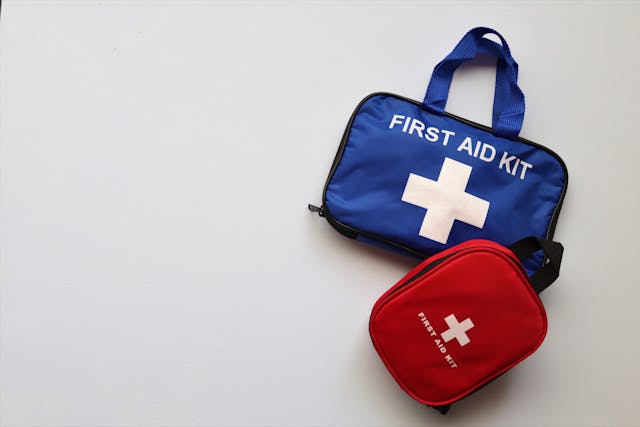
Now, I’m here to tell you that emergency items are non-negotiable. A whistle can catch the attention of rescuers far better than your voice. Reflective mirrors aren’t just for making sure you look good; they’re great for signaling in sunny conditions. And let’s talk about shelter – even a lightweight emergency space blanket or bivy sack along with a head lamp could be a lifesaver if you get stuck overnight.
Don’t worry too much about fire starting—just be sure to carry waterproof matches, or a reliable lighter. Remember, being prepared isn’t paranoid; it’s smart hiking. Choose something that resonates with you and gives you peace of mind.
I really hope that you never have to use any of these emergency items, but if you do, you’ll be thankful you had them.
Fueling Your Journey: Hydration and Nutrition Essentials
Now, let’s turn our focus to keeping your engine running during the hike – that’s going to involve hydration and nutrition. Neglecting these can lead to a less enjoyable, and potentially dangerous, experience.
First up, water is the indisputable must have here. You can use water bottles to convenient hydration reservoirs which are my preference to carry it. Each option has its merits, and it’s all about choosing what resonates with you.
More than just carrying water, it’s crucial to ensure it’s clean and safe to drink. Filters and chemical treatments are available to ensure water is clean, personally I carry enough water for the day plus extra should there be a mishap. It’s all about being prepared.
Now, on to food I like to take a mix of protein, fruit, vegetable and nuts. Others pack a sandwich, fruit, trail mix and energy bars. It’s a personal thing.
If you’re planning a longer trek, meal planning becomes essential. You’ll want to focus on lightweight, easy-to-prepare options that will fuel your adventure without taking up too much space in your pack.
Speaking of the pack, every extra ounce counts, so choose your food and water provisions wisely. Keep your food accessible, so you’re more inclined to snack regularly and maintain energy levels.
Remember, your first attempt at packing food and water for a hike doesn’t need to be perfect. You can always adjust your approach down the road based on what works best for you.
Weathering the Trail: Guarding Against Sun and Rain
You’ve stocked up on the essentials for sustenance – that’s going to include lots of water and energy-boosting snacks. But there’s more to consider for a comfortable hike, especially when it comes to weather. Your hike can quickly go from pleasant to punishing if you don’t prepare for the whims of weather.
- Sun protection: This is essential and reapplying sunscreen according to the instructions is critical. Remember to apply it to the back of your neck and ears . Don’t forget your lips – they’ll thank you for the balm. Sunglasses aren’t merely about looking cool; choose a pair with solid UV protection that’s comfortable for hours. Trust me, your eyes will appreciate the shield.
- Rain Gear: Is something you can’t overlook. You might check the forecast and see clear skies, but weather on the trails can turn on a dime. Make sure a compact, breathable rain jacket is tucked away in your pack. Consider rain pants too – they might not win any fashion prizes, but you’ll be grateful for the dryness. And a simple pack cover will keep your belongings from getting soaked. Everyone has their preference and after years of trying different gear my preference is a poncho as it fits over your pack, has a hood, is longer than a jacket as it is looser has better air-flow. My clothes end up wet from sweat when I hike in a zipped up rain jacket.
Additional Gadgets: Enhancing Your Hiking Experience
Now, you’ve got the essentials down, but there’s always room for a little something extra that can make all the difference out on the trails. I’m going to introduce you to some optional gear that, while not critical, could greatly enhance your hiking experience.
Trekking poles are again a personal choice, I don’t use them. Some folk like the stability they provide on uneven terrain and how they help reduce the strain on your knees during descents. They are also handy in creek crossings. I would recommend adjustable poles for versatility as they can be packed away when not needed.
A multi-tool is like a portable toolbox that’s invaluable when you least expect it. Whether it’s tightening a screw on your glasses or cutting through a stubborn piece of cord, you’re going to appreciate having a multi-tool when the occasion arises.
Most smartphones have great cameras these days and I use this rather than carrying a heavy and bulky camera. I occassionaly carry binoculars, particularly if doing a whale watching hike.
Conclusion: Gear Up and Get Going
And there you have it – your essential gear checklist to kickstart your hiking adventures! Remember, having the right equipment is more than just comfort; it’s about ensuring safety and enhancing your overall experience. Hiking is a rewarding activity that opens up a world of natural beauty, and you’re now equipped with the knowledge to step out with confidence.
Happy hiking!
Drop your thoughts and questions in the comments and let the community learn from your journeys.

This is an excellent guide, especially for beginners. I agree with you that footwear is the most important of all. These boots and shoes you illustrate look excellent. However, I wonder if you can recommend something for tropical hikes. I live in Japan, and especially in the summer, it is SO humid here. Could you recommend ventilated shoes or boots? If my feet get too hot and boots and socks are too heavy, it saps my energy in great heat!
Dehydration is a real danger here. Would you still recommend water or cold green tea, as the professionals do?
I’m going to bookmark your site and explore it further, also recommend it to my younger sister who’s just starting out hiking!
Linden, I only ever hike in boots due to my past ankle injuries regardless of the weather. Hiking in summer in Australia can also be very hot and humid. Personally, I would never hike with anything that is open, you would get rocks and sticks in your shoes and possibly injured. I find woollen socks absorb moisture. A shoe made from a lighter weight material may help. I think keeping hydrated is the most important thing to do in the summer. I take extra water and in one of my water bladders I add concentrated mineral salts to help replace minerasls lost through sweating. Some hikers use electrolytes but I don’t have anything with added sugar so use mineral salts. I have also added Himalayan salt to my water as it also has minerals in it. I hope this helps.
Thank you for this comprehensive guide to essential hiking gear for beginners, covering everything from footwear to hydration. I appreciate the detailed recommendations and practical advice on each item. I’m particularly interested in the section about navigating with a map and compass versus relying on GPS devices. Could you discuss some of the key advantages and disadvantages of traditional navigation tools compared to modern technology for beginners? Your insights would be greatly valuable for those starting their hiking journey. Thank you again for this informative guide — I’m sure I will be revisiting it regularly.
Hi Laura,
I’m glad you enjoyed it.
The pros of using a map and compass are; no flat batteries and having to deal with no reception or satellite in remote areas. You can improve your skills. Map and compass are cheaper. They also show a larger area.
The cons: skill is required that a novice won’t have. It’s easier to make a mistake. It’s slower.
Ideally being able to use a map and compass as a back to electronic devices up is the goal. You can always start with a map and compass on a trail that you are familiar with and practice interpreting the map in the real world.
I hope this has been helpful.
Hiking and exploring are some of the things you miss as you get older, especially after major back surgery and just having to learn to walk again, never mind hiking has been a challenge. But the advice you give is how I remember my preparation for my hiking experiences in California and North Carolina.
The importance of good boots or other suitable footwear can’t be stressed enough. First aid, I used to take a ziplock bag with the basics, or a full kit from my boat, if I was planning on camping for a night or 2.
Any backpack needs to fit you like a glove, and only take what you need, I always took a couple of cheap thin plastic sheets which had multiple purposes should the need arise, just like you have to do on these cheap airlines these days. Navigation is definitely far easier, but you should have at least a basic backup up as I have been in areas where there is no signal.
Food and water in their smallest forms are an absolute need, but having some form of visual reference to local edibles can be very helpful, I used to pack a few water sterilising tablets in my pack and never left home without my equivalent of a Swiss army knife. Good advice good article
Robby, sorry to hear about your back and having to learn to walk again. That must have been real tough. I admire those who have the courage and strength to face such adversity. All the best to you.
Your guide is spot on. As I read this guide I had to laugh to myself. Although I don’t do serious overnight or super rugged hikes, my wife and I love to do “day” hikes. We learned everything you mentioned in your guide the hard way. From blisters on our feet to almost passing out because we only took a little water and ran out. The technology part is a lifesaver. You defineately need a good compass and a small portable battery pack to keep your phones charged. We do something called Geocaching and while caching we have got ourselves turned around a few times looking for the cache. We also use the hiking poles as we are older and it helps with not only our balance on the trails but also helps us when we Geocache. One last piece of technology we use is that we pin our vehicle location on our phones. We have iPhones but I assume any phone can do it. That way if we get turned around we always know to head for our vehicle. Again, thanks for the guide. It’s sure to help out many beginners.
I wish I’d had this guide before my first hike haha would’ve saved me from overpacking and lugging around unnecessary stuff! The breakdown of must-have items like sturdy boots, a good backpack, and proper clothing is super helpful. Plus, the tips on layering and staying hydrated are spot-on. I love how it’s both informative and easy to understand. Thanks for sharing!
This guide for new hikers is really helpful! I’ve been wanting to try hiking for ages but kept putting it off because of all the gear choices. Your breakdown makes it less scary haha.
I’m torn about the footwear. I have weak ankles from an old sports injury, so I’m leaning towards boots for support. But I worry they might be too heavy for a beginner. What do you think?
The clothing layers make a lot of sense. I live in an area with really unpredictable weather, so this advice is gold. I’m thinking of getting a lightweight fleece as a mid-layer. Would that work for most conditions?
I’ll admit, I was planning to just use my phone for navigation as anyone else I guess. But you’ve convinced me to learn about maps and compasses. It seems like cool skills to have anyway. Any good resources you’d recommend for learning? And the safety gear part of the blog post really got me thinking. I’m a bit of a worrier, so I’ll probably overpack my first aid kit. Is that a bad idea? Or is it better to have too much than too little?
I’m excited to start planning my first real hike now, I have a friend who is into it, and I want to do it with her. There’s a local trail I’ve had my eye on for a while. Maybe it’s time to finally give it a shot!
Thanks for putting this guide together. It’s really boosted my confidence about getting into hiking. Can’t wait to hit the trails!
Hi there again, I have also had ankle injuries from playing netball as a kid so I prefer boots. You can get synthetic boots (gortex) that are waterproof but much lighter than leather boots. If you can find an orienteering club, you can learn there. I think its better to have an over-equiped first aid kit than not have what you need. Keep in mind the weight. All the best.
Your tips on layering clothing and bringing along a first-aid kit were spot on, and I liked how you included practical advice for choosing the right gear based on the hike’s difficulty and weather conditions. I’m curious, do you have any favorite brands or specific products that you swear by when it comes to hiking gear? Also, for beginners who might be on a budget, do you have any tips on where to invest versus where it’s okay to save a little? This article is a great resource for anyone starting out, and it’s definitely got me thinking about how I can optimize my own gear setup!